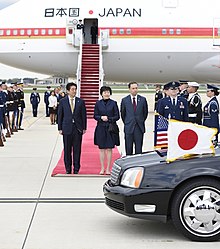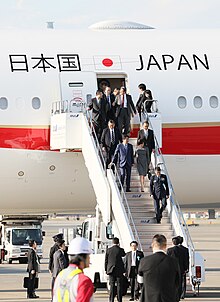Japanese Air Force One
Japanese Air Force One and Japanese Air Force Two are call sign for two Boeing 777-300ER of the Government of Japan for the carriage of the Emperor , the Prime Minister will be used and other senior officials. Each aircraft can accommodate 140 passengers and can also be used for evacuating Japanese nationals and for overseas missions by the self-defense forces.
Officially, the aircraft are designated as the exclusive government aircraft of Japan ( Japanese 日本国 政府 専 用 機 Nippon-koku seifu sen'yōki ). For official missions, the callsigns are Japanese Air Force One and Japanese Air Force Two , for unofficial ones (e.g. on training flights ) Cygnus One and Cygnus Two . The aircraft carry the aircraft registration numbers 80-1111 and 80-1112. Both aircraft always fly together during operations, with one serving as a replacement and having maintenance staff on board.
history
prehistory
During the early post-war period, the Japanese government used the then state-owned Japan Airlines for international travel .
In the 1970s, the government began investigating ways to buy government aircraft because of problems with the use of Japan Airlines: unions criticized the safety of flight personnel in rescuing Japanese nationals from conflict areas and transporting members of the Self-Defense Forces especially jeopardized. The privatization of Japan Airlines in 1987 led to significant considerations about buying government aircraft.
Boeing 747-400 (1991-2019)

The Japanese government ordered two Boeing 747-400s in 1987 in order to be able to reach almost any destination worldwide with the aircraft. Another reason for the 36 trillion yen purchase was to offset the growing trade balance between Japan and the United States.
Both aircraft were delivered in the fall of 1991. Miyazawa Kiichi was the first Prime Minister to use the plane when he visited the United States in 1993. In the same year, Emperor Akihito flew with the Japanese Air Force One for the first time.
Former German Chancellor Gerhard Schröder accompanied then Prime Minister Jun'ichirō Koizumi on the plane to see the final of the 2002 World Cup in Yokohama . Germany had qualified for this while Schröder and Koizumi were attending a G8 summit in Canada . The German government was only one Airbus A310 of Air Force available who had not enough reach to be able to fly non-stop from Canada to Japan. In the Japanese media, this short-term improvised enterprise was referred to as "ride-sharing diplomacy". It was the first time a foreign leader has flown on Japanese Air Force One.
The 747 was used to transport aid workers to New Zealand in areas hit by the Darfield earthquake in 2010 . Then Foreign Minister Seiji Maehara had also offered the plane to evacuate Japanese nationals, but was forced to withdraw the offer because the Foreign Ministry said there was not enough space for everyone on board.
In January 2011, Naoto Kan was criticized for using the plane for a trip to the World Economic Forum in Davos while 500 Japanese nationals were in troubled Cairo . The Asahi Shimbun newspaper reported that the State Department asked for the aircraft to be used, but Kan gave priority to and declined the World Economic Forum. He denied that this discussion took place. The Foreign Ministry said it was difficult to obtain a permit to fly through Egyptian airspace and a landing permit at short notice. Naoto Kan later wanted to travel to Germany by plane to watch the Japanese team at the final of the 2011 Women's World Cup , but consultants advised him not to do so due to the high costs and possible outcry from the media over the 2011 Tōhoku earthquake .
The Democratic Party asked for public comments in 2011 about the Japanese government's budget. Many responses criticized the Japanese Air Force One as wasteful and wasteful and called for the government to resume renting machines as needed. However, after there were several hostage dramas in Algeria in 2013, Prime Minister Shinzō Abe of the Liberal Democratic Party decided that the planes should continue to serve national security.
The 747 machines completed 349 missions during their service life.
Boeing 777-300ER (2019-)
Japan Airlines was responsible for the maintenance, ground handling and other technical support of the aircraft until 2019, as well as for training the crews (which, however, are employed by the air self-defense forces). The airline had continued to perform this service so far, although it had not had a Boeing 747 in its own fleet since 2011, which meant that costs rose. The largest Japanese airline, All Nippon Airways , also retired its last Boeing 747 in 2014. The only airline in Japan that still operates the Boeing 747 is the cargo airline Nippon Cargo Airlines . The Ministry of Defense concluded that this would be a problem in the long term and that the government should either buy a new aircraft type or rent civilian aircraft again as needed. Contracting other alternatives such as a foreign airline or the air self-defense forces with the maintenance of the 747 were too expensive for the ministry and also logistically problematic. The high fuel consumption of the Boeing 747-400 was also a problem.
In March 2012, the Yomiuri Shimbun newspaper reported that the Boeing 787 was the top candidate as the successor to the Boeing 747 due to its very low fuel consumption and the high number of Japanese components. However, the Nihon Keizai Shimbun reported in July 2013 that the Boeing 777 was the leading candidate because its capacity was closer to that of the Boeing 747. It was also announced that talks were already underway with the governments concerned. The Airbus A350 was also suggested by some officials.
The government announced in August 2014 that the two Boeing 747-400s will be replaced by two Boeing 777-300ERs in 2019 . For the first time, All Nippon Airways is responsible for maintenance, ground handling, technical support and pilot training. In April 2015, a modernized livery was presented, which both Boeing 777s carry. In August 2018, the first of the two Boeing 777s with the aircraft registration number 80-1111 was delivered to the Ministry of Defense. She had been in Switzerland since 2016 , where the cabin was fitted out. The second aircraft with registration number 80-1112 landed in Japan in December 2018. The machines were first used on April 22, 2019, when Prime Minister Abe set out on an eight-day trip abroad.
Furnishing
Boeing 747-400:
The Boeing 747-400 included a private sleeping / office area in the front part of the main deck, which was intended for the prime minister, but could also be converted for the imperial family or other VIPs. The middle section comprised seats that could be converted into flat beds in a 2 + 3 + 2 arrangement for senior officials, a VIP booth with two seats, a conference table with seats that could be converted into beds, and a secretarial area with office equipment. The rear part of the cabin was equipped with seats (also 2 + 3 + 2 arrangement), which corresponded to the short-haul business class seats of a scheduled airline and were intended for reporters, and there was also a table for press conferences. During evacuations, the passengers took their places in these seats. On the upper deck there were economy class seats in a 2 + 3 and 3 + 3 arrangement, which were used for communication and on-board personnel. As with the US Air Force One, four General Electric CF6s were used as engines .
Boeing 777-300ER:
The Boeing 777-300ER also has a private room for the prime minister, the imperial family and similar passengers in the front of the aircraft. Behind it is a conference room with six seats and two tables, which can be converted into two separate rooms by means of a partition wall if necessary. Also in the front part of the machine is a work area with office equipment. Behind this are 21 All Nippon Airways (ANA) business class seats in a 1 + 2 + 1 arrangement for senior officials and members of the government. The rear of the aircraft is equipped with 85 premium economy class seats, also from ANA, in a 2 + 3 + 2 arrangement. Press members usually sit here; during evacuation missions the evacuees. The 777 no longer has a press conference table.
Color scheme of the aircraft
Boeing 747-400:
The fuselage of the 747-400 was white with a light gray underside and red / gold window band. On the vertical tail and the wings emblazoned the flag of Japan and on the bow of the word was Japan in Kanji and written in English. The engines and winglets were also white. Below the vertical stabilizer, the word air self-defense forces (Japanese 航空 自衛隊 Kōkū Jieitai ) was written in Kanji.
Boeing 777-300ER :
The color scheme has been modernized for the 777-300ER: the light gray underside and the red / gold window band are now curved. In addition, the lettering Japan (or 日本国 ) is now no longer above the first, but above the second door.
commitment
Initially, the Japanese Air Force One operated as a civil aircraft with aircraft registration numbers JA8091 and JA8092 , but was handed over to the Department of Defense in 1992 and re-registered as defense aircraft with registration numbers 20-1101 and 20-1102 . Since then, the aircraft have been operated by the Air Self-Defense Forces and were stationed at Chitose Air Base . The crew consists of 17 to 19 members, including two to four pilots, twelve flight attendants and three members operate the communications facility.
For short flights, the government also uses the Gulfstream IV and Eurocopter EC 225 helicopters . The Gulfstream IV has only been used once by a Prime Minister; Yasuo Fukuda flew her from Beijing to Nagasaki at short notice because the Boeing 747 was not operational.
In contrast to the US Air Force One, the Japanese government machine can only be used for official flights and not for private trips by the prime minister or the imperial family.
When Japanese nationals are evacuated from particularly dangerous areas abroad, members of the ground self-defense forces and the Ministry of Defense are also on board.
Individual evidence
- ↑ aviationwire.jp - 政府 専 用 機 、 千 歳 基地 で 交代 式 典 現行 機 は 地球 365 周 (Japanese), accessed April 23, 2014
- ↑ aviationwire.jp: 政府 専 用 機 、 新 デ ザ イ ン 決定 (Japanese), accessed January 18, 2016
- ^ New Boeing state jet featuring Hinomaru-themed livery arrives in Hokkaido. In: The Japan Times . August 17, 2018, accessed January 12, 2019 .
- ↑ planespotters.net - 80-1112 Japan Air Self-Defense Force (JASDF) Boeing 777-300 (English), accessed January 12, 2019
- ↑ Abe leaves for Europe, US and Canada with Osaka G20 and China's 'Belt and Road' on his mind. In: The Japan Times . April 22, 2019, accessed April 23, 2019 .
- ↑ youtube.com - 新 政府 専 用 機 の 内部 初 公開 (Japanese), accessed April 23, 2019
- ↑ airfleets.net: Japanese Gvmt Fleet of B747 , accessed January 18, 2016





